Fresh basil is one of the most rewarding herbs to grow indoors. With its distinctive fragrance and versatile flavor, basil can elevate a wide variety of dishes, from pasta sauces and salads to soups and drinks. Best of all, basil thrives in small spaces, making it the perfect choice for home kitchens. With proper care and a few simple techniques, you can ensure that your basil plants remain healthy, productive, and flavorful throughout the year.
Why Basil Belongs in the Kitchen
Basil is a natural companion for the home cook. Instead of relying on store-bought bunches that wilt within days, having fresh basil growing just steps from your stove ensures convenience and freshness. Aside from culinary uses, basil also brings a refreshing aroma to your kitchen and a touch of green beauty to your home environment. Its compact size and relatively low maintenance make it one of the easiest herbs for beginner gardeners.
Choosing the Right Variety
Not all basil varieties grow the same way, so choosing the right one for your kitchen is key. Some common options include:
-
Genovese Basil – Classic Italian variety, excellent for pesto and sauces.
-
Greek Basil – Compact and bushy with tiny leaves, great for small containers.
-
Purple Basil – Attractive ornamental variety with a spicier taste.
-
Lemon Basil – Offers a refreshing citrus note for salads and fish dishes.
If your kitchen space is limited, opt for compact types like Greek basil, which fit neatly into smaller pots without spreading too much.
Preparing Containers and Soil
Basil thrives in containers, provided they allow good drainage. Select pots that are at least 6–8 inches deep and have drainage holes at the bottom. Terra cotta and ceramic pots are excellent choices, but any container that prevents waterlogging will work.
For soil, use a light, well-draining potting mix rather than heavy garden soil. Mixing in compost or organic matter improves fertility and encourages strong, leafy growth. Basil prefers soil that holds some moisture but doesn’t stay soggy, so a blend with perlite or coconut coir is ideal.
Light Requirements
Basil is a sun-loving herb. To grow successfully indoors, it needs at least six hours of direct sunlight daily. A sunny windowsill—especially one that faces south—is the best location. If natural light in your kitchen is limited, supplement with a grow light. Small LED grow lamps work well for countertop gardens and can be set on timers to provide consistent light throughout the day. Without enough sunlight, basil may grow leggy and produce fewer leaves, so ensuring adequate light is crucial.
Watering and Moisture Care
Watering basil correctly is one of the most important aspects of care. Basil prefers evenly moist soil but cannot tolerate waterlogged conditions. Check the soil by touching the top inch—if it feels dry, water thoroughly until some drains from the bottom of the pot. Avoid leaving the pot sitting in standing water, as this can cause root rot.
In dry indoor environments, misting the leaves occasionally can help, but always ensure the foliage dries quickly to prevent fungal problems. Morning watering is best, as it allows the plant to absorb moisture during the day.
Harvesting for Continued Growth
Regular harvesting not only provides fresh leaves for cooking but also encourages the plant to grow more vigorously. Start harvesting once your basil has at least six healthy leaves. Snip leaves from the top of the plant, just above a pair of leaf nodes, to stimulate branching and create a bushier shape.
Be consistent with harvesting—leaving the plant untrimmed can cause it to become tall and spindly. If you see flower buds forming, pinch them off right away. Flowering often changes the flavor of the leaves, making them more bitter.
Maintaining Healthy Plants
To keep your basil productive, provide occasional feeding with a balanced, diluted liquid fertilizer every few weeks. Too much fertilizer can reduce the intensity of flavor, so moderation is best.
Rotate your pots occasionally to ensure even light exposure on all sides. Watch for pests like aphids or spider mites, especially in warm indoor conditions. If they appear, a gentle spray of water or a mild soap solution usually takes care of the problem.
Space-Saving Kitchen Ideas
Even in small kitchens, you can grow basil creatively:
-
Hanging planters save counter space and add greenery near windows.
-
Mason jars or recycled containers can serve as pots with proper drainage layers.
-
Vertical herb walls allow you to grow multiple plants in compact areas.
-
Hydroponic kits provide a soil-free, clean way to grow basil indoors.
Final Thoughts
Growing basil in your kitchen is simple, rewarding, and practical. With the right container, light, and watering routine, basil can provide months of fresh leaves right where you need them most. By harvesting regularly and maintaining proper care, you can enjoy a constant supply of flavorful basil while adding a touch of green to your kitchen. Whether you choose the classic Genovese or the bright citrusy lemon basil, your dishes—and your home—will be enriched by this easy-to-grow herb.



